NUR 504: Critical Analysis of Research Studies in Healthcare Domain
VerifiedAdded on 2023/06/10
|10
|1994
|186
Report
AI Summary
This report presents a critical analysis of two healthcare research articles. The first article examines interventions to increase influenza vaccination rates in older adults, focusing on research design, data collection methods, and trustworthiness. It highlights the use of randomized controlled trials (RCTs) and mixed methods for data collection, emphasizing the importance of minimizing bias. The second article explores pneumonia care in nursing homes from the perspectives of residents and family members, utilizing a qualitative descriptive study design. It discusses the protection of human rights, sampling techniques, and data collection procedures, while also addressing the enhancement of trustworthiness through peer review and reflective journal entries. Both analyses evaluate the strengths and limitations of the research methodologies employed in the respective studies.
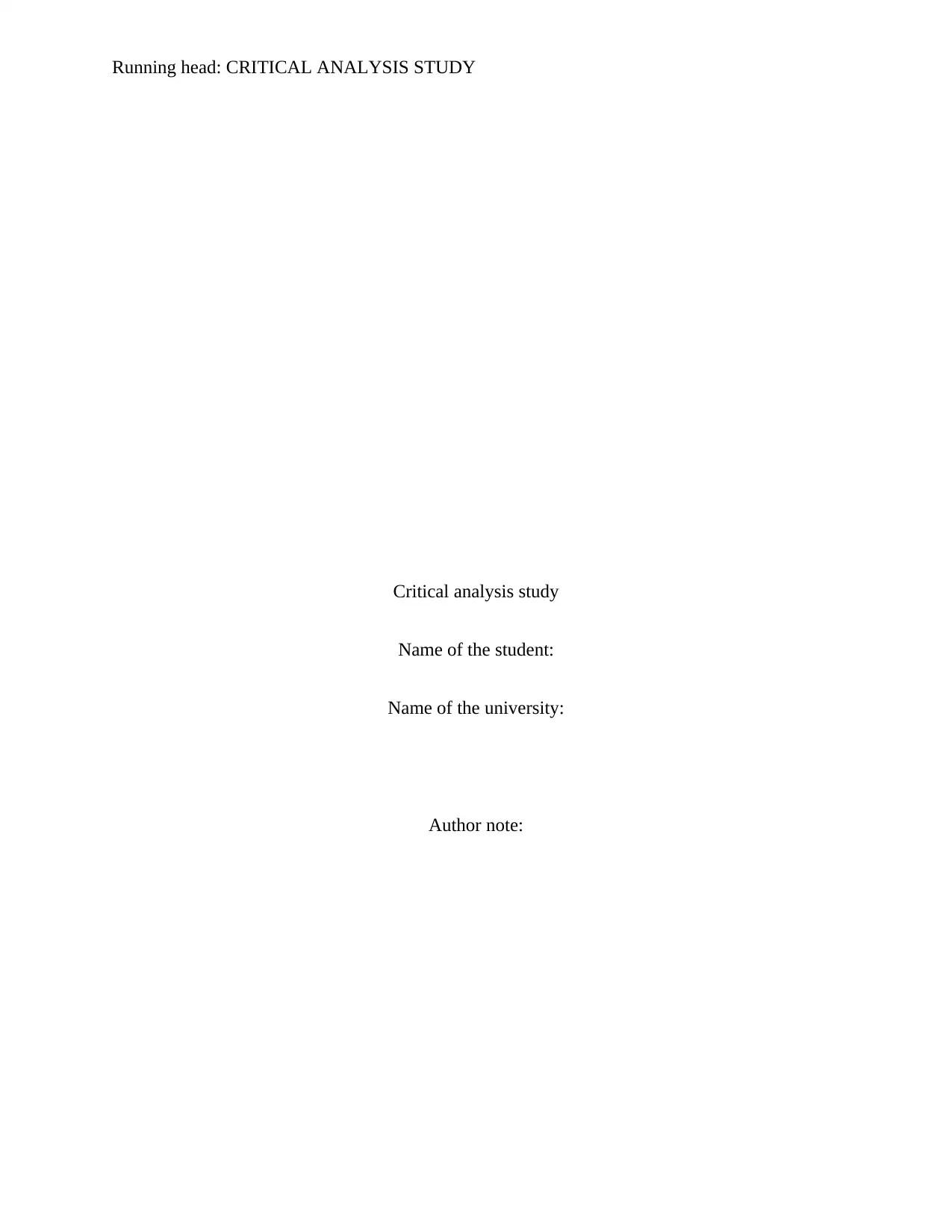
Running head: CRITICAL ANALYSIS STUDY
Critical analysis study
Name of the student:
Name of the university:
Author note:
Critical analysis study
Name of the student:
Name of the university:
Author note:
Paraphrase This Document
Need a fresh take? Get an instant paraphrase of this document with our AI Paraphraser
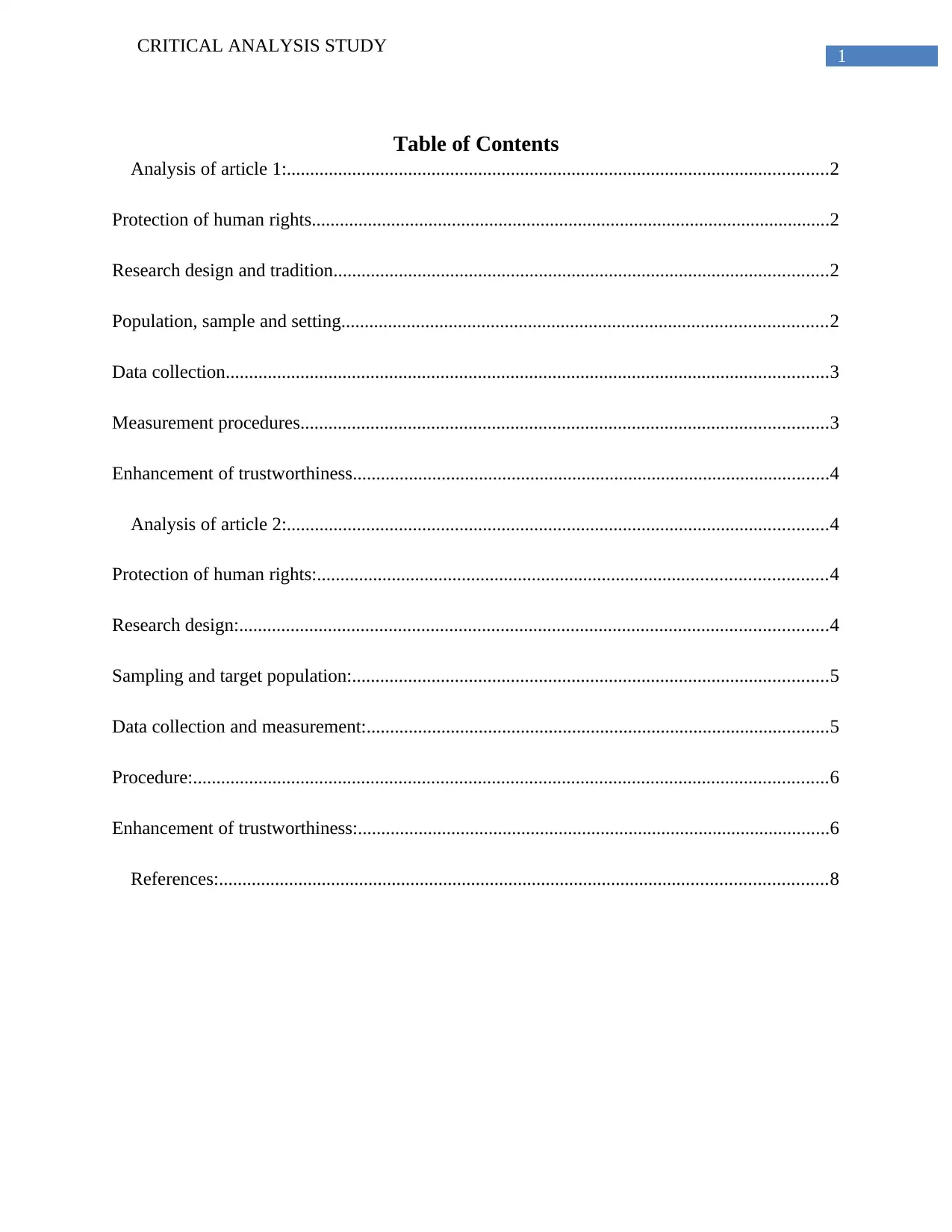
1
CRITICAL ANALYSIS STUDY
Table of Contents
Analysis of article 1:....................................................................................................................2
Protection of human rights...............................................................................................................2
Research design and tradition..........................................................................................................2
Population, sample and setting........................................................................................................2
Data collection.................................................................................................................................3
Measurement procedures.................................................................................................................3
Enhancement of trustworthiness......................................................................................................4
Analysis of article 2:....................................................................................................................4
Protection of human rights:.............................................................................................................4
Research design:..............................................................................................................................4
Sampling and target population:......................................................................................................5
Data collection and measurement:...................................................................................................5
Procedure:........................................................................................................................................6
Enhancement of trustworthiness:.....................................................................................................6
References:..................................................................................................................................8
CRITICAL ANALYSIS STUDY
Table of Contents
Analysis of article 1:....................................................................................................................2
Protection of human rights...............................................................................................................2
Research design and tradition..........................................................................................................2
Population, sample and setting........................................................................................................2
Data collection.................................................................................................................................3
Measurement procedures.................................................................................................................3
Enhancement of trustworthiness......................................................................................................4
Analysis of article 2:....................................................................................................................4
Protection of human rights:.............................................................................................................4
Research design:..............................................................................................................................4
Sampling and target population:......................................................................................................5
Data collection and measurement:...................................................................................................5
Procedure:........................................................................................................................................6
Enhancement of trustworthiness:.....................................................................................................6
References:..................................................................................................................................8
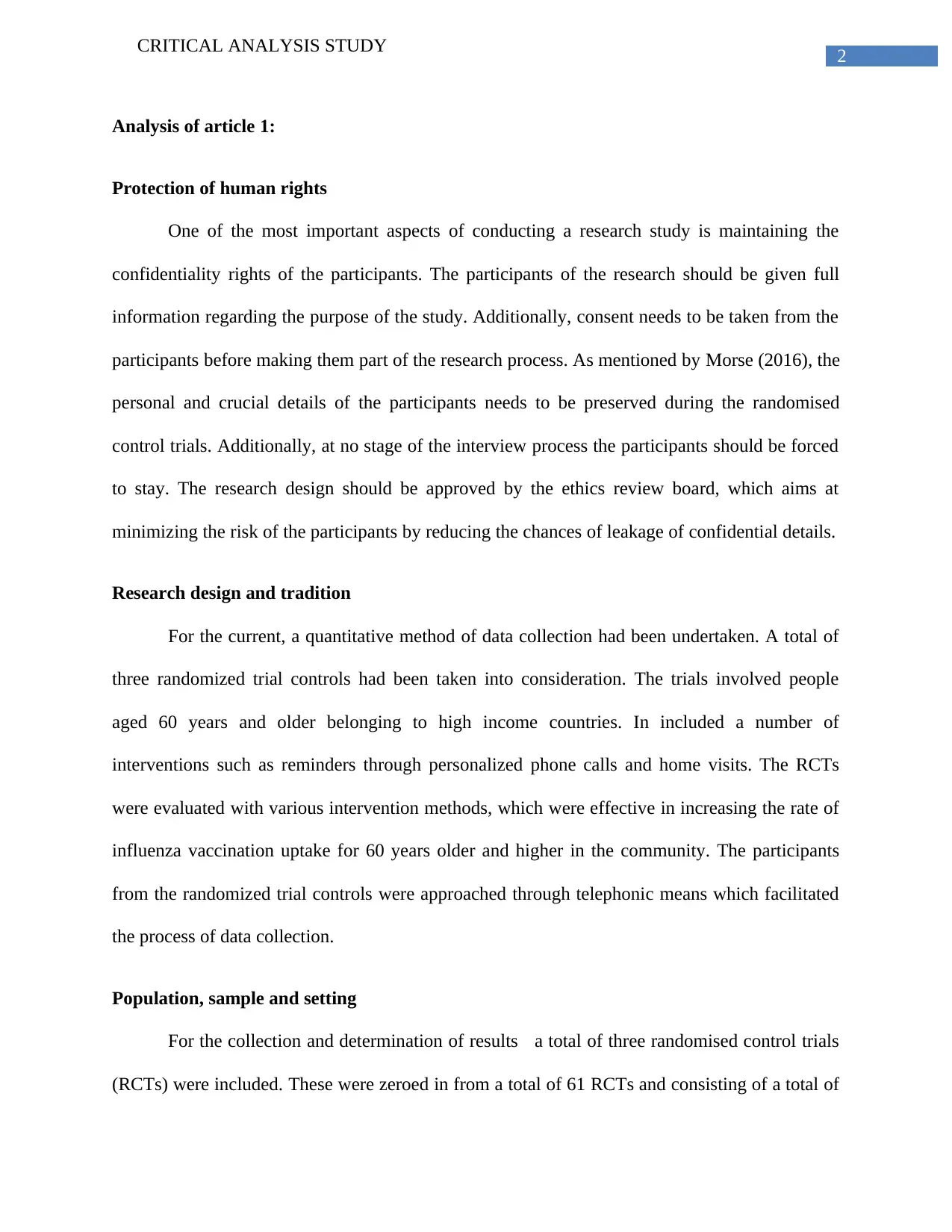
2
CRITICAL ANALYSIS STUDY
Analysis of article 1:
Protection of human rights
One of the most important aspects of conducting a research study is maintaining the
confidentiality rights of the participants. The participants of the research should be given full
information regarding the purpose of the study. Additionally, consent needs to be taken from the
participants before making them part of the research process. As mentioned by Morse (2016), the
personal and crucial details of the participants needs to be preserved during the randomised
control trials. Additionally, at no stage of the interview process the participants should be forced
to stay. The research design should be approved by the ethics review board, which aims at
minimizing the risk of the participants by reducing the chances of leakage of confidential details.
Research design and tradition
For the current, a quantitative method of data collection had been undertaken. A total of
three randomized trial controls had been taken into consideration. The trials involved people
aged 60 years and older belonging to high income countries. In included a number of
interventions such as reminders through personalized phone calls and home visits. The RCTs
were evaluated with various intervention methods, which were effective in increasing the rate of
influenza vaccination uptake for 60 years older and higher in the community. The participants
from the randomized trial controls were approached through telephonic means which facilitated
the process of data collection.
Population, sample and setting
For the collection and determination of results a total of three randomised control trials
(RCTs) were included. These were zeroed in from a total of 61 RCTs and consisting of a total of
CRITICAL ANALYSIS STUDY
Analysis of article 1:
Protection of human rights
One of the most important aspects of conducting a research study is maintaining the
confidentiality rights of the participants. The participants of the research should be given full
information regarding the purpose of the study. Additionally, consent needs to be taken from the
participants before making them part of the research process. As mentioned by Morse (2016), the
personal and crucial details of the participants needs to be preserved during the randomised
control trials. Additionally, at no stage of the interview process the participants should be forced
to stay. The research design should be approved by the ethics review board, which aims at
minimizing the risk of the participants by reducing the chances of leakage of confidential details.
Research design and tradition
For the current, a quantitative method of data collection had been undertaken. A total of
three randomized trial controls had been taken into consideration. The trials involved people
aged 60 years and older belonging to high income countries. In included a number of
interventions such as reminders through personalized phone calls and home visits. The RCTs
were evaluated with various intervention methods, which were effective in increasing the rate of
influenza vaccination uptake for 60 years older and higher in the community. The participants
from the randomized trial controls were approached through telephonic means which facilitated
the process of data collection.
Population, sample and setting
For the collection and determination of results a total of three randomised control trials
(RCTs) were included. These were zeroed in from a total of 61 RCTs and consisting of a total of
⊘ This is a preview!⊘
Do you want full access?
Subscribe today to unlock all pages.

Trusted by 1+ million students worldwide
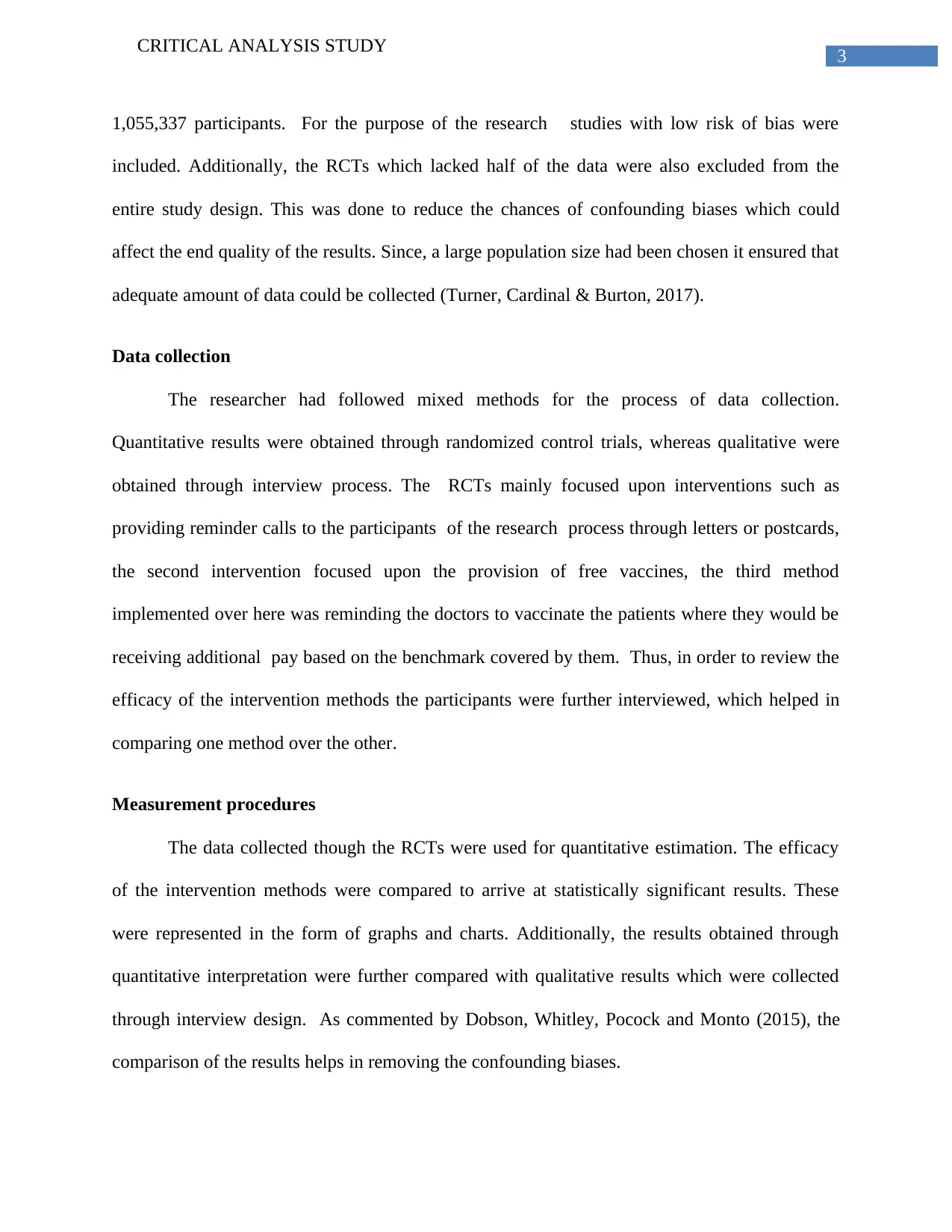
3
CRITICAL ANALYSIS STUDY
1,055,337 participants. For the purpose of the research studies with low risk of bias were
included. Additionally, the RCTs which lacked half of the data were also excluded from the
entire study design. This was done to reduce the chances of confounding biases which could
affect the end quality of the results. Since, a large population size had been chosen it ensured that
adequate amount of data could be collected (Turner, Cardinal & Burton, 2017).
Data collection
The researcher had followed mixed methods for the process of data collection.
Quantitative results were obtained through randomized control trials, whereas qualitative were
obtained through interview process. The RCTs mainly focused upon interventions such as
providing reminder calls to the participants of the research process through letters or postcards,
the second intervention focused upon the provision of free vaccines, the third method
implemented over here was reminding the doctors to vaccinate the patients where they would be
receiving additional pay based on the benchmark covered by them. Thus, in order to review the
efficacy of the intervention methods the participants were further interviewed, which helped in
comparing one method over the other.
Measurement procedures
The data collected though the RCTs were used for quantitative estimation. The efficacy
of the intervention methods were compared to arrive at statistically significant results. These
were represented in the form of graphs and charts. Additionally, the results obtained through
quantitative interpretation were further compared with qualitative results which were collected
through interview design. As commented by Dobson, Whitley, Pocock and Monto (2015), the
comparison of the results helps in removing the confounding biases.
CRITICAL ANALYSIS STUDY
1,055,337 participants. For the purpose of the research studies with low risk of bias were
included. Additionally, the RCTs which lacked half of the data were also excluded from the
entire study design. This was done to reduce the chances of confounding biases which could
affect the end quality of the results. Since, a large population size had been chosen it ensured that
adequate amount of data could be collected (Turner, Cardinal & Burton, 2017).
Data collection
The researcher had followed mixed methods for the process of data collection.
Quantitative results were obtained through randomized control trials, whereas qualitative were
obtained through interview process. The RCTs mainly focused upon interventions such as
providing reminder calls to the participants of the research process through letters or postcards,
the second intervention focused upon the provision of free vaccines, the third method
implemented over here was reminding the doctors to vaccinate the patients where they would be
receiving additional pay based on the benchmark covered by them. Thus, in order to review the
efficacy of the intervention methods the participants were further interviewed, which helped in
comparing one method over the other.
Measurement procedures
The data collected though the RCTs were used for quantitative estimation. The efficacy
of the intervention methods were compared to arrive at statistically significant results. These
were represented in the form of graphs and charts. Additionally, the results obtained through
quantitative interpretation were further compared with qualitative results which were collected
through interview design. As commented by Dobson, Whitley, Pocock and Monto (2015), the
comparison of the results helps in removing the confounding biases.
Paraphrase This Document
Need a fresh take? Get an instant paraphrase of this document with our AI Paraphraser
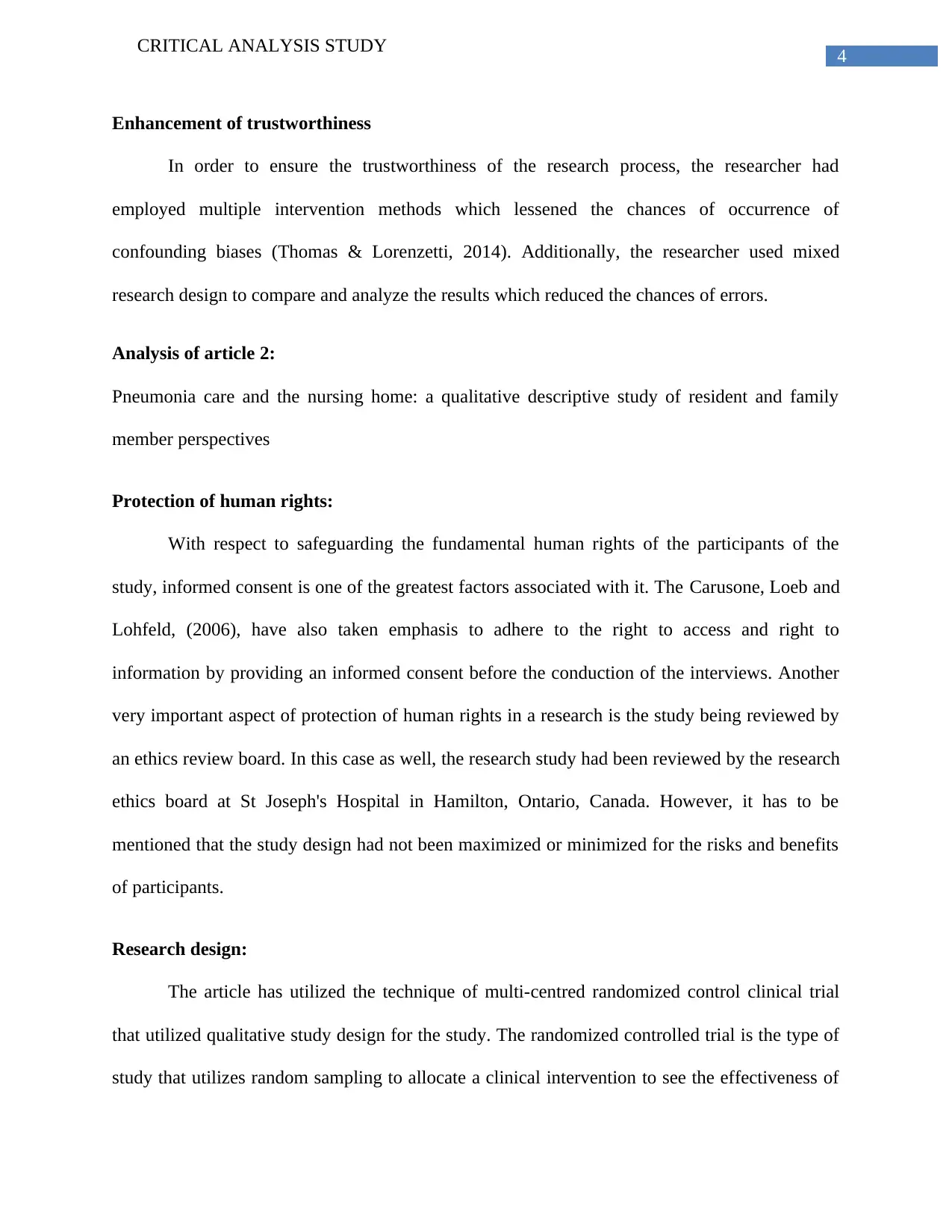
4
CRITICAL ANALYSIS STUDY
Enhancement of trustworthiness
In order to ensure the trustworthiness of the research process, the researcher had
employed multiple intervention methods which lessened the chances of occurrence of
confounding biases (Thomas & Lorenzetti, 2014). Additionally, the researcher used mixed
research design to compare and analyze the results which reduced the chances of errors.
Analysis of article 2:
Pneumonia care and the nursing home: a qualitative descriptive study of resident and family
member perspectives
Protection of human rights:
With respect to safeguarding the fundamental human rights of the participants of the
study, informed consent is one of the greatest factors associated with it. The Carusone, Loeb and
Lohfeld, (2006), have also taken emphasis to adhere to the right to access and right to
information by providing an informed consent before the conduction of the interviews. Another
very important aspect of protection of human rights in a research is the study being reviewed by
an ethics review board. In this case as well, the research study had been reviewed by the research
ethics board at St Joseph's Hospital in Hamilton, Ontario, Canada. However, it has to be
mentioned that the study design had not been maximized or minimized for the risks and benefits
of participants.
Research design:
The article has utilized the technique of multi-centred randomized control clinical trial
that utilized qualitative study design for the study. The randomized controlled trial is the type of
study that utilizes random sampling to allocate a clinical intervention to see the effectiveness of
CRITICAL ANALYSIS STUDY
Enhancement of trustworthiness
In order to ensure the trustworthiness of the research process, the researcher had
employed multiple intervention methods which lessened the chances of occurrence of
confounding biases (Thomas & Lorenzetti, 2014). Additionally, the researcher used mixed
research design to compare and analyze the results which reduced the chances of errors.
Analysis of article 2:
Pneumonia care and the nursing home: a qualitative descriptive study of resident and family
member perspectives
Protection of human rights:
With respect to safeguarding the fundamental human rights of the participants of the
study, informed consent is one of the greatest factors associated with it. The Carusone, Loeb and
Lohfeld, (2006), have also taken emphasis to adhere to the right to access and right to
information by providing an informed consent before the conduction of the interviews. Another
very important aspect of protection of human rights in a research is the study being reviewed by
an ethics review board. In this case as well, the research study had been reviewed by the research
ethics board at St Joseph's Hospital in Hamilton, Ontario, Canada. However, it has to be
mentioned that the study design had not been maximized or minimized for the risks and benefits
of participants.
Research design:
The article has utilized the technique of multi-centred randomized control clinical trial
that utilized qualitative study design for the study. The randomized controlled trial is the type of
study that utilizes random sampling to allocate a clinical intervention to see the effectiveness of
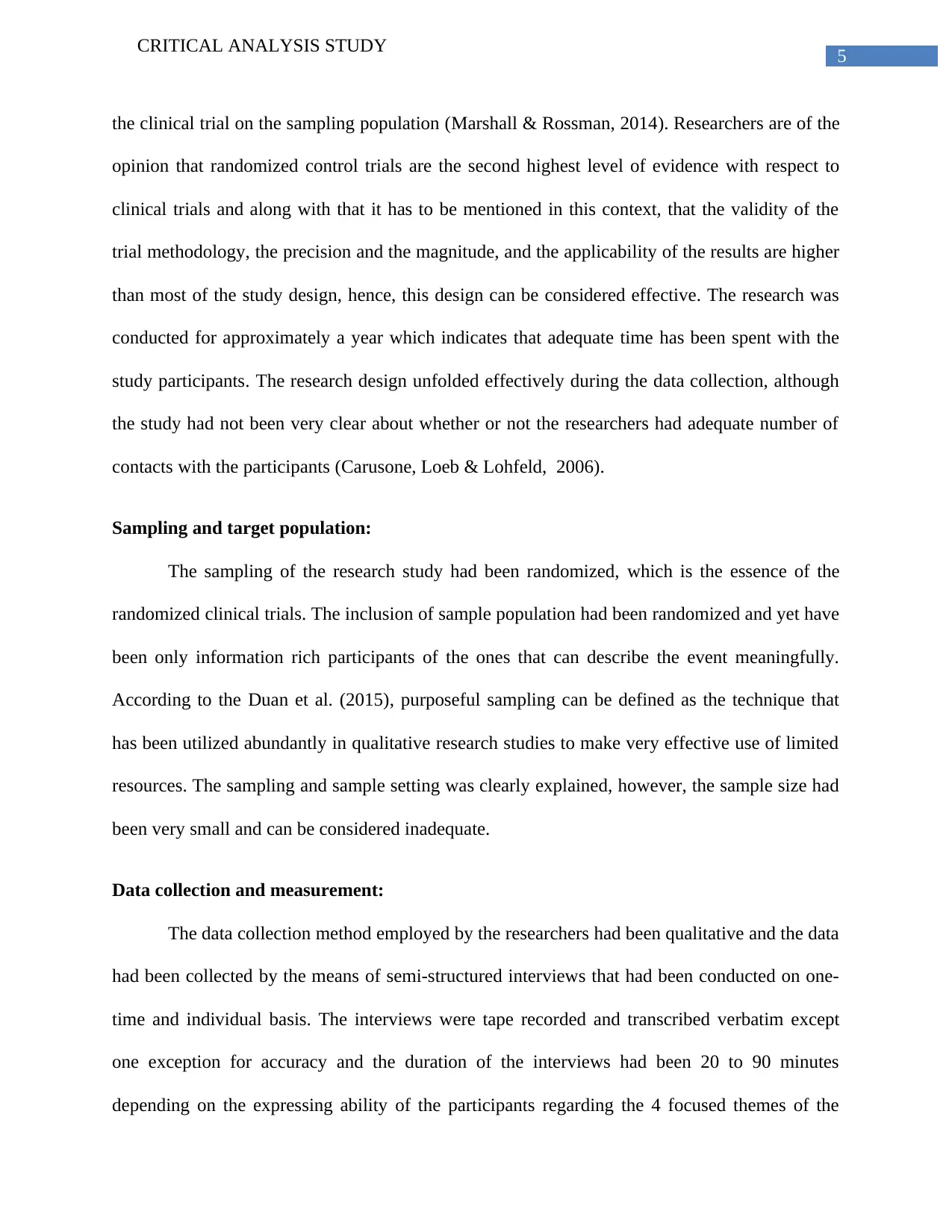
5
CRITICAL ANALYSIS STUDY
the clinical trial on the sampling population (Marshall & Rossman, 2014). Researchers are of the
opinion that randomized control trials are the second highest level of evidence with respect to
clinical trials and along with that it has to be mentioned in this context, that the validity of the
trial methodology, the precision and the magnitude, and the applicability of the results are higher
than most of the study design, hence, this design can be considered effective. The research was
conducted for approximately a year which indicates that adequate time has been spent with the
study participants. The research design unfolded effectively during the data collection, although
the study had not been very clear about whether or not the researchers had adequate number of
contacts with the participants (Carusone, Loeb & Lohfeld, 2006).
Sampling and target population:
The sampling of the research study had been randomized, which is the essence of the
randomized clinical trials. The inclusion of sample population had been randomized and yet have
been only information rich participants of the ones that can describe the event meaningfully.
According to the Duan et al. (2015), purposeful sampling can be defined as the technique that
has been utilized abundantly in qualitative research studies to make very effective use of limited
resources. The sampling and sample setting was clearly explained, however, the sample size had
been very small and can be considered inadequate.
Data collection and measurement:
The data collection method employed by the researchers had been qualitative and the data
had been collected by the means of semi-structured interviews that had been conducted on one-
time and individual basis. The interviews were tape recorded and transcribed verbatim except
one exception for accuracy and the duration of the interviews had been 20 to 90 minutes
depending on the expressing ability of the participants regarding the 4 focused themes of the
CRITICAL ANALYSIS STUDY
the clinical trial on the sampling population (Marshall & Rossman, 2014). Researchers are of the
opinion that randomized control trials are the second highest level of evidence with respect to
clinical trials and along with that it has to be mentioned in this context, that the validity of the
trial methodology, the precision and the magnitude, and the applicability of the results are higher
than most of the study design, hence, this design can be considered effective. The research was
conducted for approximately a year which indicates that adequate time has been spent with the
study participants. The research design unfolded effectively during the data collection, although
the study had not been very clear about whether or not the researchers had adequate number of
contacts with the participants (Carusone, Loeb & Lohfeld, 2006).
Sampling and target population:
The sampling of the research study had been randomized, which is the essence of the
randomized clinical trials. The inclusion of sample population had been randomized and yet have
been only information rich participants of the ones that can describe the event meaningfully.
According to the Duan et al. (2015), purposeful sampling can be defined as the technique that
has been utilized abundantly in qualitative research studies to make very effective use of limited
resources. The sampling and sample setting was clearly explained, however, the sample size had
been very small and can be considered inadequate.
Data collection and measurement:
The data collection method employed by the researchers had been qualitative and the data
had been collected by the means of semi-structured interviews that had been conducted on one-
time and individual basis. The interviews were tape recorded and transcribed verbatim except
one exception for accuracy and the duration of the interviews had been 20 to 90 minutes
depending on the expressing ability of the participants regarding the 4 focused themes of the
⊘ This is a preview!⊘
Do you want full access?
Subscribe today to unlock all pages.

Trusted by 1+ million students worldwide
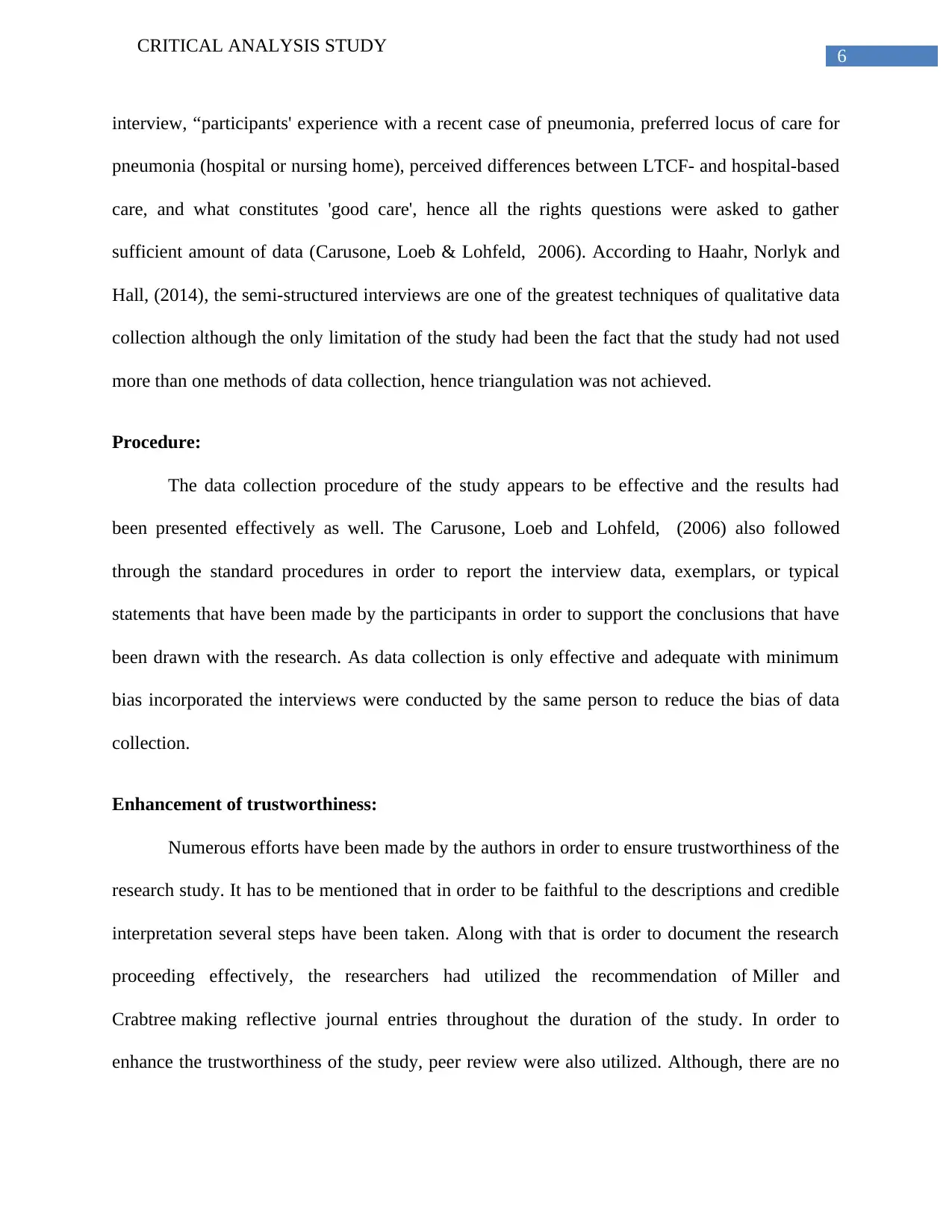
6
CRITICAL ANALYSIS STUDY
interview, “participants' experience with a recent case of pneumonia, preferred locus of care for
pneumonia (hospital or nursing home), perceived differences between LTCF- and hospital-based
care, and what constitutes 'good care', hence all the rights questions were asked to gather
sufficient amount of data (Carusone, Loeb & Lohfeld, 2006). According to Haahr, Norlyk and
Hall, (2014), the semi-structured interviews are one of the greatest techniques of qualitative data
collection although the only limitation of the study had been the fact that the study had not used
more than one methods of data collection, hence triangulation was not achieved.
Procedure:
The data collection procedure of the study appears to be effective and the results had
been presented effectively as well. The Carusone, Loeb and Lohfeld, (2006) also followed
through the standard procedures in order to report the interview data, exemplars, or typical
statements that have been made by the participants in order to support the conclusions that have
been drawn with the research. As data collection is only effective and adequate with minimum
bias incorporated the interviews were conducted by the same person to reduce the bias of data
collection.
Enhancement of trustworthiness:
Numerous efforts have been made by the authors in order to ensure trustworthiness of the
research study. It has to be mentioned that in order to be faithful to the descriptions and credible
interpretation several steps have been taken. Along with that is order to document the research
proceeding effectively, the researchers had utilized the recommendation of Miller and
Crabtree making reflective journal entries throughout the duration of the study. In order to
enhance the trustworthiness of the study, peer review were also utilized. Although, there are no
CRITICAL ANALYSIS STUDY
interview, “participants' experience with a recent case of pneumonia, preferred locus of care for
pneumonia (hospital or nursing home), perceived differences between LTCF- and hospital-based
care, and what constitutes 'good care', hence all the rights questions were asked to gather
sufficient amount of data (Carusone, Loeb & Lohfeld, 2006). According to Haahr, Norlyk and
Hall, (2014), the semi-structured interviews are one of the greatest techniques of qualitative data
collection although the only limitation of the study had been the fact that the study had not used
more than one methods of data collection, hence triangulation was not achieved.
Procedure:
The data collection procedure of the study appears to be effective and the results had
been presented effectively as well. The Carusone, Loeb and Lohfeld, (2006) also followed
through the standard procedures in order to report the interview data, exemplars, or typical
statements that have been made by the participants in order to support the conclusions that have
been drawn with the research. As data collection is only effective and adequate with minimum
bias incorporated the interviews were conducted by the same person to reduce the bias of data
collection.
Enhancement of trustworthiness:
Numerous efforts have been made by the authors in order to ensure trustworthiness of the
research study. It has to be mentioned that in order to be faithful to the descriptions and credible
interpretation several steps have been taken. Along with that is order to document the research
proceeding effectively, the researchers had utilized the recommendation of Miller and
Crabtree making reflective journal entries throughout the duration of the study. In order to
enhance the trustworthiness of the study, peer review were also utilized. Although, there are no
Paraphrase This Document
Need a fresh take? Get an instant paraphrase of this document with our AI Paraphraser

7
CRITICAL ANALYSIS STUDY
evidences of research reflexivity in the study and thick description (Carusone, Loeb & Lohfeld,
2006).
.
CRITICAL ANALYSIS STUDY
evidences of research reflexivity in the study and thick description (Carusone, Loeb & Lohfeld,
2006).
.
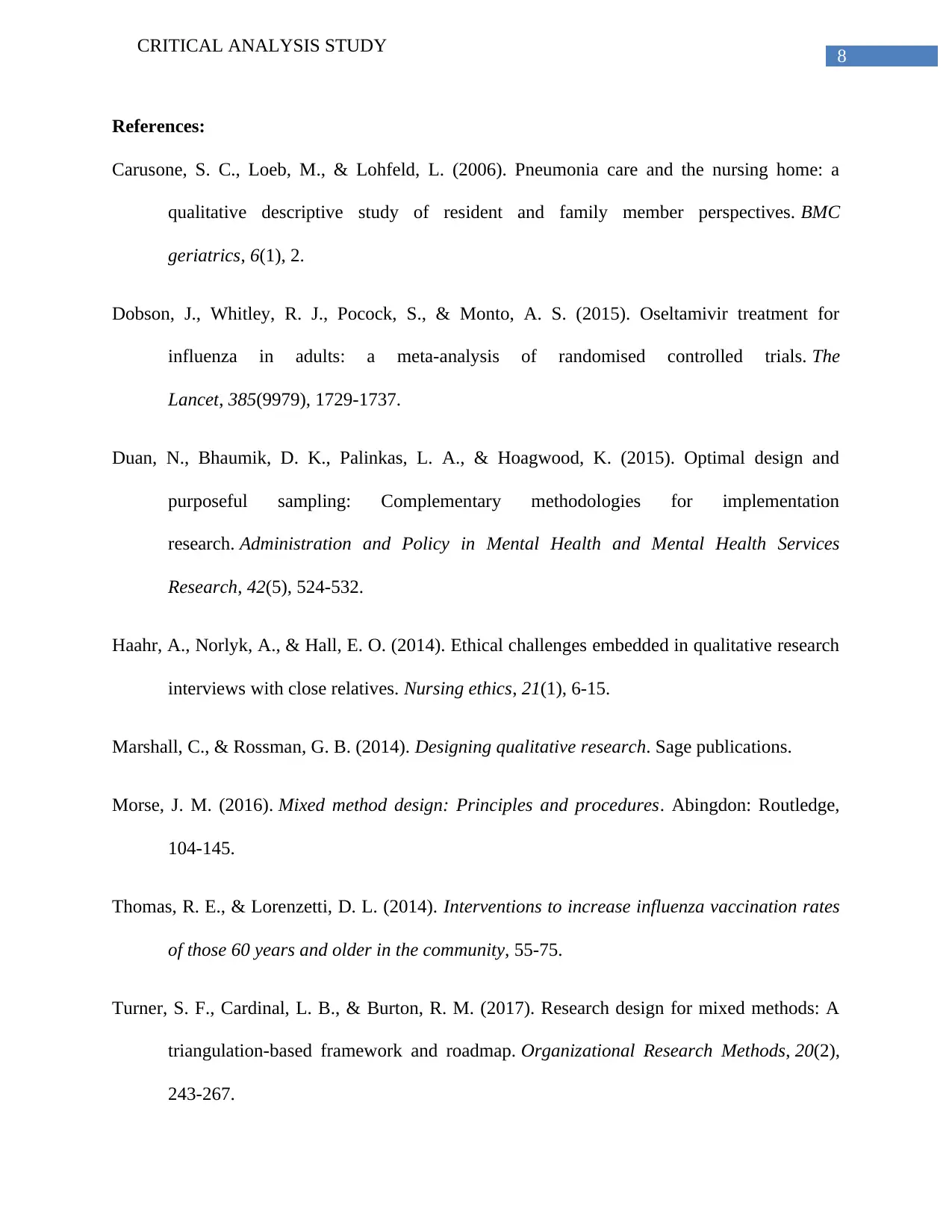
8
CRITICAL ANALYSIS STUDY
References:
Carusone, S. C., Loeb, M., & Lohfeld, L. (2006). Pneumonia care and the nursing home: a
qualitative descriptive study of resident and family member perspectives. BMC
geriatrics, 6(1), 2.
Dobson, J., Whitley, R. J., Pocock, S., & Monto, A. S. (2015). Oseltamivir treatment for
influenza in adults: a meta-analysis of randomised controlled trials. The
Lancet, 385(9979), 1729-1737.
Duan, N., Bhaumik, D. K., Palinkas, L. A., & Hoagwood, K. (2015). Optimal design and
purposeful sampling: Complementary methodologies for implementation
research. Administration and Policy in Mental Health and Mental Health Services
Research, 42(5), 524-532.
Haahr, A., Norlyk, A., & Hall, E. O. (2014). Ethical challenges embedded in qualitative research
interviews with close relatives. Nursing ethics, 21(1), 6-15.
Marshall, C., & Rossman, G. B. (2014). Designing qualitative research. Sage publications.
Morse, J. M. (2016). Mixed method design: Principles and procedures. Abingdon: Routledge,
104-145.
Thomas, R. E., & Lorenzetti, D. L. (2014). Interventions to increase influenza vaccination rates
of those 60 years and older in the community, 55-75.
Turner, S. F., Cardinal, L. B., & Burton, R. M. (2017). Research design for mixed methods: A
triangulation-based framework and roadmap. Organizational Research Methods, 20(2),
243-267.
CRITICAL ANALYSIS STUDY
References:
Carusone, S. C., Loeb, M., & Lohfeld, L. (2006). Pneumonia care and the nursing home: a
qualitative descriptive study of resident and family member perspectives. BMC
geriatrics, 6(1), 2.
Dobson, J., Whitley, R. J., Pocock, S., & Monto, A. S. (2015). Oseltamivir treatment for
influenza in adults: a meta-analysis of randomised controlled trials. The
Lancet, 385(9979), 1729-1737.
Duan, N., Bhaumik, D. K., Palinkas, L. A., & Hoagwood, K. (2015). Optimal design and
purposeful sampling: Complementary methodologies for implementation
research. Administration and Policy in Mental Health and Mental Health Services
Research, 42(5), 524-532.
Haahr, A., Norlyk, A., & Hall, E. O. (2014). Ethical challenges embedded in qualitative research
interviews with close relatives. Nursing ethics, 21(1), 6-15.
Marshall, C., & Rossman, G. B. (2014). Designing qualitative research. Sage publications.
Morse, J. M. (2016). Mixed method design: Principles and procedures. Abingdon: Routledge,
104-145.
Thomas, R. E., & Lorenzetti, D. L. (2014). Interventions to increase influenza vaccination rates
of those 60 years and older in the community, 55-75.
Turner, S. F., Cardinal, L. B., & Burton, R. M. (2017). Research design for mixed methods: A
triangulation-based framework and roadmap. Organizational Research Methods, 20(2),
243-267.
⊘ This is a preview!⊘
Do you want full access?
Subscribe today to unlock all pages.

Trusted by 1+ million students worldwide

9
CRITICAL ANALYSIS STUDY
CRITICAL ANALYSIS STUDY
1 out of 10
Related Documents
Your All-in-One AI-Powered Toolkit for Academic Success.
+13062052269
info@desklib.com
Available 24*7 on WhatsApp / Email
![[object Object]](/_next/static/media/star-bottom.7253800d.svg)
Unlock your academic potential
Copyright © 2020–2025 A2Z Services. All Rights Reserved. Developed and managed by ZUCOL.





